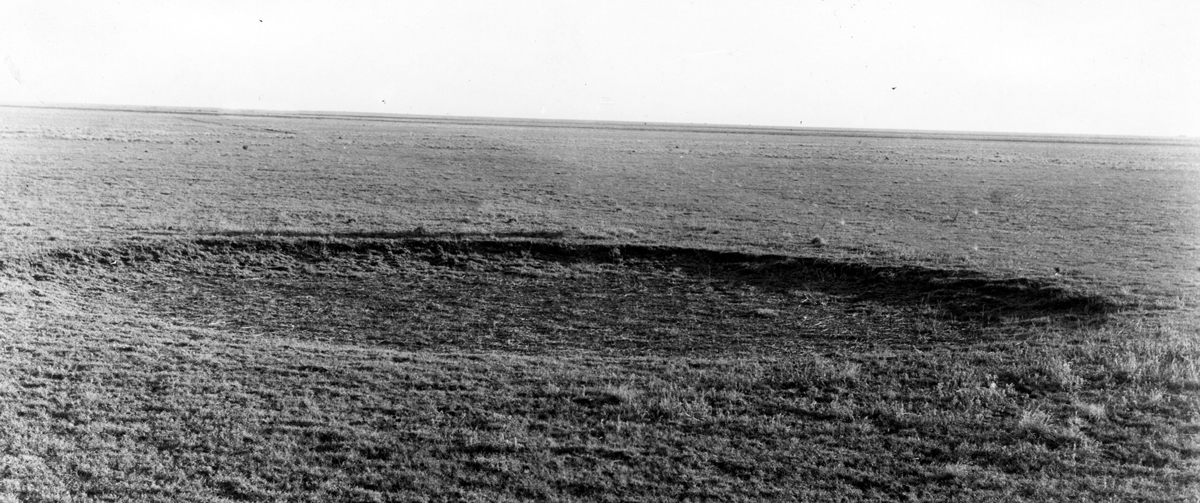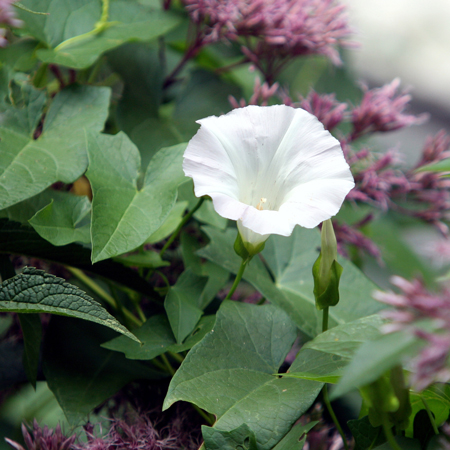After waiting for the Missouri River fog to lift, the expedition sets out at 7 am and encamps near present Nemaha, Nebraska. Lewis’s chronometer stops, and he collects a specimen of hedge bindweed.
The Chronometer Stops
by Yellowstone Public Radio[1]Originally aired weekdays by Yellowstone Public Radio during the Bicentennial observance of 2003-2006. Narrated by Hal Hansen. Scripts by Whit Hansen and Ed Jacobson. Produced by Leni Holliman. © … Continue reading
Hunting Elk
went on Shore, with a view to Kill Some elk, passed thro open plains, and barroney lands [barrens] Crossed three butifull Small Streams of water, Saw great quantity of Cherres Plums, Grapes & Berries of Difft. Kinds
—William Clark
Treeless Plains
Kansas Buffalo Wallow

Photo by an unknown photographer: Plate 2 in U.S. Geological Survey. Folio 212. 1920. A settler, road, and farm have been digitally obscured.
The text accompanying the above photo states, “Typical surface of the country underlain by the Ogallala formation of the High Plains of western Kansas, buffalo wallow; shallow circular depression in the level surface, in foreground. Haskell County, Kansas.”
this plain appeared to extend 20 or 30 miles, those Hills have but little timber, and the Plain appears to Continu back of them—
—William Clark
Stopped Chronometer
This evening I discovered that my Chronometer had stoped, nor can I assign any cause for this accedent; she had been wound up the preceding noon as usual. This is the third instance in which the instrument has stopt in a similar manner since she has been in my possession,
—Meriwether Lewis
Lost Specimen No. 28
No. 28.— taken on the 17th July at the bald prarie— is a large convolvalist a fine white colour; the vines are very extensive and run in every direction intwining themselves about the larger weeds and bending them down is [in] such manner as to make the open grownds 〈impassable〉 or praries where they grow almost impassable; the root is about the size and shape of the vine and enters it so deep that I could not find it’s brances tho’ I dug as much as 2 feet in surch of it.— the leaf is of a tonge like form pale green even on the edges.
—Meriwether Lewis
Moulton identifies this lost specimen, received by John Vaughn in 1805 (see The Donation Book), as Calystegia sepium, formerly Convolvulus sepium, hedge bindweed.[2]This specimen was collected either on the 15th or 17th. Gary E. Moulton, ed. Journals, “Fort Mandan Miscellany”, vol 3:458, 467.
Experience the Lewis and Clark Trail
The Lewis and Clark Trail Experience—our sister site at lewisandclark.travel—connects the world to people and places on the Lewis and Clark Trail.
Plan a trip related to July 15, 1804:

Notes
| ↑1 | Originally aired weekdays by Yellowstone Public Radio during the Bicentennial observance of 2003-2006. Narrated by Hal Hansen. Scripts by Whit Hansen and Ed Jacobson. Produced by Leni Holliman. © 2003 by Yellowstone Public Radio. |
|---|---|
| ↑2 | This specimen was collected either on the 15th or 17th. Gary E. Moulton, ed. Journals, “Fort Mandan Miscellany”, vol 3:458, 467. |

